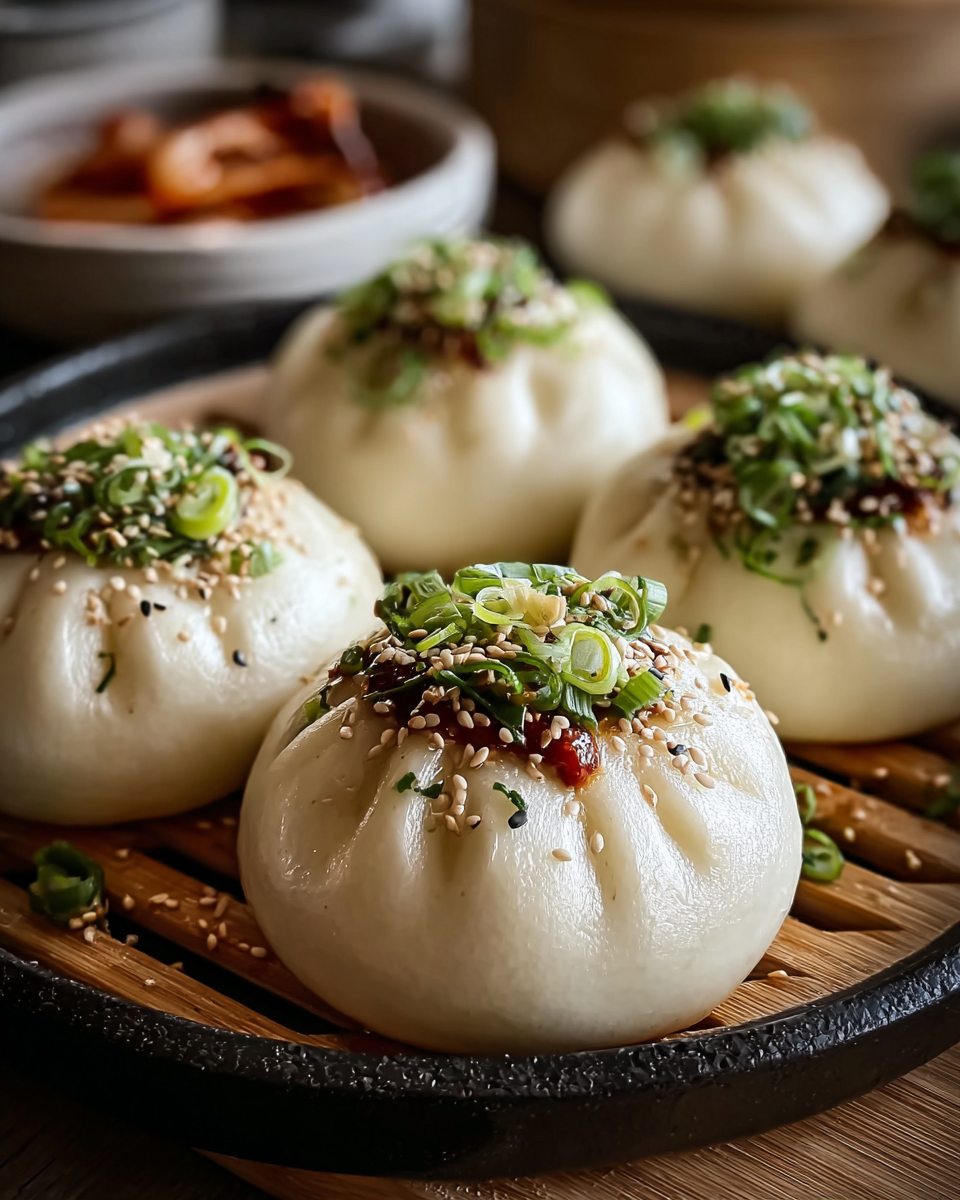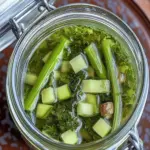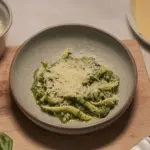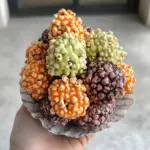These Korean Steamed Buns are a delicate treat, with a soft, pillowy exterior and a savory filling that will transport your taste buds straight to the heart of Korea. Whether filled with savory vegetables or a touch of meat, these buns bring warmth and comfort in every bite. Ideal for a cozy dinner or as an appetizer at your next gathering, these buns are easy to make and can be tailored to your tastes. The filling can be adjusted based on your preference, and the fluffy texture of the bun is perfect for absorbing the rich, flavorful filling. They’re perfect for pairing with a dipping sauce or serving alongside a savory soup!
Full recipe:
Ingredients:
-
2 cups all-purpose flour
-
2 teaspoons instant yeast
-
3/4 cup warm water
-
2 tablespoons sugar
-
1 tablespoon vegetable oil
-
1/2 teaspoon salt
-
1/4 cup finely chopped cabbage
-
1/4 cup shredded carrots
-
1/4 cup cooked ground pork or chicken (optional)
-
2 tablespoons soy sauce
-
1 teaspoon sesame oil
-
1/2 teaspoon minced garlic
-
1/2 teaspoon ginger, grated
Directions:
-
In a bowl, combine warm water, sugar, and yeast. Let it sit for 5 minutes until the yeast activates.
-
In a separate bowl, mix flour and salt. Add the yeast mixture to the flour mixture and knead until you have a smooth dough.
-
Cover the dough with a damp towel and let it rise for about 1 hour, or until it doubles in size.
-
While the dough is rising, prepare the filling: In a skillet, heat sesame oil over medium heat and sauté garlic and ginger until fragrant. Add cabbage, carrots, and cooked meat, and cook for 5-7 minutes. Stir in soy sauce and cook for an additional 2 minutes. Remove from heat and let it cool.
-
Once the dough has risen, punch it down and divide it into 10 equal portions. Roll each portion into a small ball.
-
Flatten each ball into a circle and place a spoonful of filling in the center. Pinch the edges together to seal.
-
Place the buns in a steamer basket lined with parchment paper and steam for 10-12 minutes, or until puffed and cooked through.
-
Serve the buns hot with dipping sauce of choice.
Prep Time: 15 minutes | Cooking Time: 25 minutes | Total Time: 40 minutes
Kcal: 150 kcal per bun | Servings: 10 servings
Background of Korean Steamed Buns
Korean steamed buns, often referred to as Jjinppang in Korea, are a beloved dish known for their soft and fluffy texture. These buns are traditionally filled with a variety of savory or sweet fillings, offering versatility in flavors to suit various preferences. Though the recipe is originally rooted in Asian culinary traditions, the buns have gained international popularity due to their comforting qualities and ease of preparation.
The origins of these buns trace back to Korea’s rich culinary history, with influences from neighboring countries like China. Traditionally served as a snack or appetizer, Korean steamed buns have evolved over time, with diverse fillings ranging from savory pork and vegetables to sweet red bean paste or coconut cream. Today, they are a staple at Korean street food markets, festivals, and family gatherings, loved for their unique combination of textures and the soft, pillowy nature of the dough.
Why This Recipe is the Best Choice
Korean steamed buns are the epitome of comfort food, offering a perfect balance of flavors and textures. The key to making these buns truly special lies in the dough, which should be soft, slightly chewy, and perfectly steamed. When done right, they offer a delightful contrast between the fluffy exterior and the rich, savory filling inside.
The recipe for Korean steamed buns provides an ideal base that can be customized to suit various dietary preferences. Whether you prefer a vegetarian version with tofu and vegetables or a meaty filling like pork or beef, the dough is incredibly versatile. The gentle steaming process preserves the freshness and moisture of the ingredients, giving the buns their characteristic soft, spongy texture.
Health Benefits of Korean Steamed Buns
While Korean steamed buns are primarily considered comfort food, they also come with a number of health benefits. The dough, made from simple ingredients like flour, yeast, and water, is free of unhealthy fats, making it a lighter option compared to fried snacks. The steaming process also helps retain nutrients better than frying, offering a healthier alternative for those seeking to reduce oil intake.
Depending on the filling you choose, these buns can be quite nutritious. For example, a vegetable-based filling with ingredients like cabbage, carrots, and tofu provides a good amount of fiber, vitamins, and minerals. On the other hand, meat-filled buns, such as those with pork or chicken, provide a satisfying dose of protein. By incorporating vegetables or lean meats, you can easily transform these buns into a well-balanced meal.
Step-by-Step Guide to Making Korean Steamed Buns
The process of making these buns begins with preparing the dough. The yeast helps create a soft, fluffy texture, while the flour adds structure. Once the dough has risen, the next step is to prepare the filling. Whether you go for a savory pork filling or a vegetarian version with tofu and veggies, this is where you can get creative. Some variations also incorporate kimchi for an extra burst of flavor, adding a bit of spice to the buns.
Shaping the buns is an essential step. Each piece of dough is rolled into a small circle, filled with the desired ingredients, and sealed to ensure the filling stays inside during steaming. After allowing the buns to rise for a second time, the steaming process begins. The result is a batch of soft, fluffy buns that are perfect for serving at family meals, parties, or even as a snack.
The Secret to Perfect Korean Steamed Buns
One of the main factors in achieving the perfect Korean steamed bun lies in the dough preparation. The dough should be kneaded long enough to develop gluten, which is crucial for its chewy consistency. A light touch when shaping the buns is also important to ensure they remain fluffy and airy.
The steaming process is key as well. Steaming the buns rather than frying them preserves the dough’s light texture, while ensuring the filling is cooked evenly without losing moisture. If you don’t have a steamer, you can easily improvise by placing a heatproof plate in a pot of boiling water and covering it with a lid. This technique will still provide the same soft, delicious result.
Versatility and Customization
One of the best things about Korean steamed buns is their versatility. The dough is highly adaptable, so you can experiment with various fillings to suit your taste. From spicy pork to savory tofu or even sweet fillings like red bean paste and coconut cream, the possibilities are endless. This allows you to customize the recipe for different occasions, whether you’re preparing a comforting family meal or serving an array of snacks at a gathering.
You can also create a fusion of flavors by combining different ingredients. For instance, a Korean-spiced beef filling with a touch of garlic and sesame oil pairs wonderfully with a vegetable medley, while a sweet berry compote filling adds a delightful twist for dessert.
Storage and Reheating
If you’re not able to finish all the buns in one sitting, no worries! Korean steamed buns store well in an airtight container in the refrigerator for up to 3-5 days. They can also be frozen for future enjoyment. Simply steam them again when ready to serve for the best texture and flavor. This makes them an ideal make-ahead option for busy days or for those who want to prepare a batch for future meals.
Conclusion
Korean steamed buns are an amazing culinary treat that offers both flavor and versatility. Their soft, fluffy texture and the ability to customize the filling make them a perfect addition to any meal or gathering. Whether you’re making them for yourself, your family, or guests, Korean steamed buns are sure to impress with their delicious taste and unique presentation. Plus, with the option to customize and make them healthier with vegetables or lean meats, these buns can easily fit into a balanced, wholesome diet.






